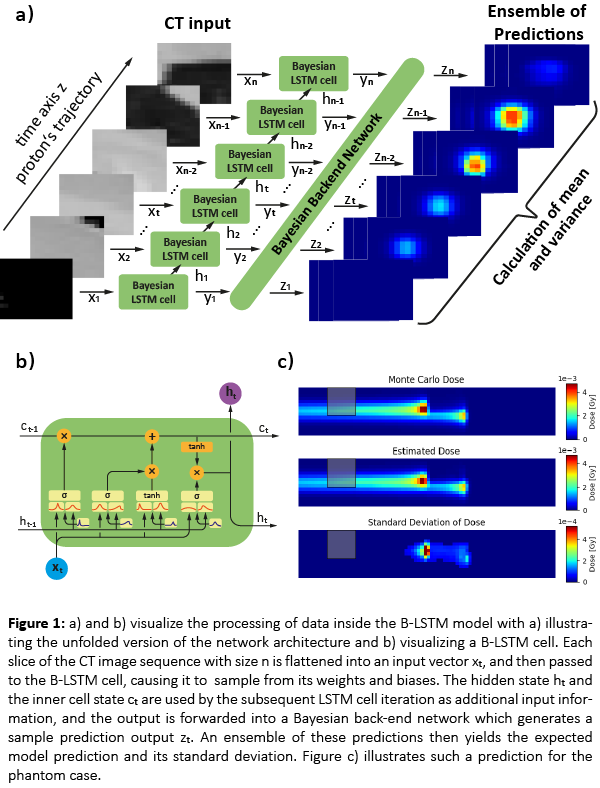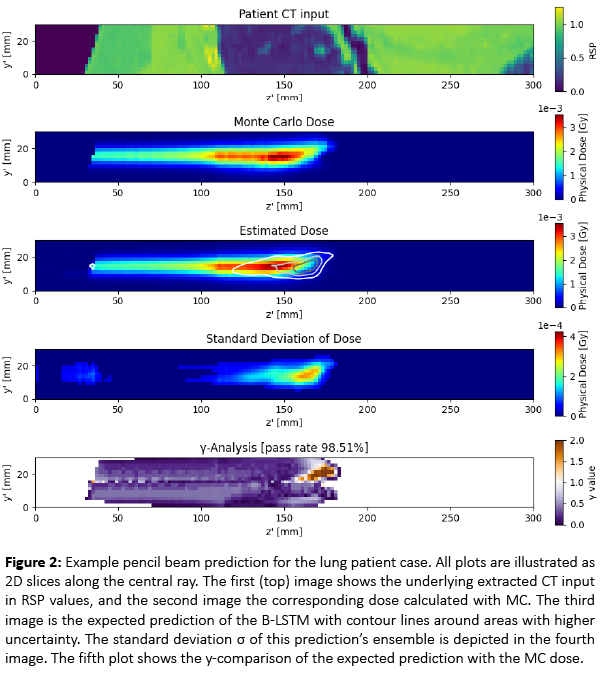Comprehensive proton dose prediction with Bayesian LSTMs
OC-0775
Abstract
Comprehensive proton dose prediction with Bayesian LSTMs
Authors: Luke Voss1,2,3, Ahmad Neishabouri3,4,5, Tim Ortkamp2,3,6,7, Niklas Wahl2,3
1Ruprecht Karl University of Heidelberg, Institute of Computer Science, Heidelberg, Germany; 2German Cancer Research Center (DKFZ), Department of Medical Physics in Radiation Oncology, Heidelberg, Germany; 3Heidelberg Institute for Radiation Oncology (HIRO), Department of Medical Physics in Radiation Oncology, Heidelberg, Germany; 4Heidelberg Ion Therapy Center, HIT, Heidelberg, Germany; 5German Cancer Research Center (DKFZ), Clinical Cooperation Unit Radiation Oncology, Heidelberg, Germany; 6Karlsruhe Institute of Technology (KIT), Steinbuch Centre for Computing (SCC), Heidelberg, Germany; 7Helmholtz Information and Data Science School for Health, HIDSS4Health, Heidelberg, Germany
Show Affiliations
Hide Affiliations
Purpose or Objective
Deep learning-based proton dose calculation engines may achieve near Monte Carlo (MC) prediction accuracy while maintaining millisecond prediction time per pencil beam (PB). However, such networks tend to be overconfident in their prediction and face a lack of interpretability in the prediction finding process. For clinical translation and quality assurance, quantifying the prediction model uncertainty would be desirable - the same way an MC algorithm provides statistical noise.
Material and Methods
This approach uses a Bayesian long-short term memory network (B-LSTM) to incorporate such an uncertainty estimate by replacing deterministic weights and biases in the network architecture with probability distributions. Our B-LSTM (see Figure 1) with corresponding Bayesian back-end network is based on a previous deterministic PB dose prediction model (Neishabouri et al. 2021): It was tested and trained on MC PB doses with initial beam energies of 104.25 MeV, once in a constructed phantom case with block heterogeneities and once on a lung case. The B-LSTM’s mean prediction was compared to MC doses, its equivalent deterministic structure, and the original LSTM by Neishabouri et al. 2021 with a [1%, 3 mm] global γ-analysis. The accuracy of the predicted standard deviation (σ) was quantified with a significance test (≥ 3σ) against dose differences.

Results
Table 1 reports the average γ-pass rates for the two performed experiments with runtimes reported for the patient case. The B-LSTM predictions demonstrate good agreement with the MC simulations and comparable results to the deterministic networks. As illustrated in Figure 2, the B-LSTM correctly identifies the areas of high uncertainty, i.e., σ correlates well with the location of voxels failing the γ-criterion. The σ prediction performed best on the phantom dataset, but was less accurate on the patient lung dataset, partially due to interpolation artifacts. The percentage of voxels significantly deviating ( ≥ 3σ) was 0.2% for the phantom case and 5.56% for the patient case.
| Phantom | Patient |
|
| y-pass rate mean (%)
| y-pass rate mean (%)
| Runtime (ms)*
|
Neishabouri LSTM
| 96.00
| 99.60
| 9.8
|
Deterministic LSTM
| 97.81
| 99.70
| 8.0
|
B-LSTM
(Ensemble size = 100)
| 97.93
| 99.59
| 67**
|
* using Nvidia RTX A5000 GPU
** 57.6 ms for prediction ensemble + 9.4 ms for mean & variance

Conclusion
A B-LSTM can achieve state-of-the-art prediction accuracy with the added benefit of comprehensively quantifying the magnitude and spatial distribution of the prediction uncertainty. Even with ensembles of 100 predictions, the runtime overhead stayed below a factor of 10 and could be further reduced by pruning and computational optimization. Expanding the patient training dataset may improve prediction accuracy and the Bayesian approach may similarly be applied to other recent approaches (e.g., transformer networks as used in Pastor-Serrano & Perko 2022). Thus, B-LSTMs may serve as a first step towards comprehensible deep-learning dose prediction, enabling clinical translation in the future.